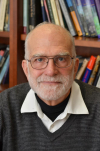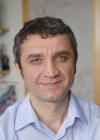Mismatch: Human Origins and Modern Disease
Stephen Stearns, Yale University
Ruslan Medzhitov, Yale School of Medicine
Summary:
The human body is a mosaic of features with an enormous range of evolutionary ages. This Symposium covers that range by discussing the impacts on health of vulnerabilities that originated from 1.5 billion to 2 million years ago. Multicellularity (1.5 bya) made tissues, organs, large size, and cancer possible. The vertebrate immune system (450 mya), which protects us against rapidly evolving pathogens, has inflammation and autoimmune disease built into it. Lactation (200 mya), which supports infant growth and disease resistance, made possible breast cancer, and when breast milk is not used, the risks of allergies, obesity, and metabolic disorders increase. Menstruation (40 mya) improved the quality control of defective offspring while making women vulnerable to dysmenorrhea and premenstrual syndrome. Highly invasive placentas (15 mya) improved fetal nutrition and growth, but the ability of those cells to invade foreign tissue opened the door to metastatic cancer. Since we diverged from other primates (6 mya), our aging and our reproduction got uniquely human signatures, and while bipedalism allowed us to run fast and handle objects with our hands, it brought with it problems with childbirth, back and joint pain, and diseases of the spine. While social parenting (5 mya) made possible shorter interbirth intervals and a new ontogenetic phase (childhood), it was accompanied by babies fatter at birth and harder to deliver and may be involved in menopause. When we became hairless (2 mya) and got abundant sweat glands (2 mya), we could run far and work hard in hot weather, but that made us vulnerable to skin cancers. The hunter-gatherer lifestyle (2 mya) expanded our microbiome, with new elements playing an immunoregulatory role, but it made women vulnerable to polycystic ovarian syndrome. It became the reference lifestyle for the mismatch diseases of civilization.
Media for each talk can be played by clicking on icons in the table below, or by clicking on the individual talk titles below and then the attachment file at the bottom of the page.
| Speakers | Media | Session |
|---|---|---|
 Pascal Gagneux  Stephen Stearns |
|
Welcome & Opening Remarks Welcome by CARTA Executive Co-Director, Pascal Gagneux. Opening remarks by Event Co-chair, Stephen Stearns. |
 Steve Frank |
|
Cancer is normal development spun out of control Cancer is the origin of a novel tissue that attracts resources, spreads beyond boundaries, avoids normal controls, and escapes immunity. A novel tissue arises in the same way that bodies are built from nothing, by development. Cancer is normal development spun out of control. It is the great plasticity and power of development, without the overarching controls that guide normal development toward an integrated adult form. Instead, whenever a newly developed kind of tissue acquires the ability... read more |
 Andrea Graham |
|
The evolution of powerful yet perilous immune systems Pressures of life on Earth experienced by our ancestors – as multicellular beings, as hosts to parasites, and as home to microbes – shaped the evolved structure and function of our immune systems. Some of the traits favored by natural selection have conferred resistance against infections while opening vulnerabilities to autoimmune diseases. I will illustrate why analysis of the deep-time origins of mammalian immune systems reveals general principles of optimal defense and helps to explain why... read more |
 Deena Emera |
|
Is there a point to periods? The evolutionary history of menstruation and implications for women's health Menstruation is the cyclical shedding of the endometrium triggered by falling progesterone levels. Menstruation is a rare trait found in less than 2% of mammals and likely evolved independently at least 4 times. Why do some mammals menstruate while most do not? The leading hypothesis is that menstruation occurs as a nonadaptive consequence of spontaneous decidualization of the endometrium, which evolved to increase biosensoring of embryo quality. While the trait of spontaneous decidualization (... read more |
 Günter Wagner |
|
Does the placenta drive the evolution of cancer malignancy? The rate of cancer and cancer malignancy differ greatly among mammalian species. The placental – maternal interface is also highly variable between placental mammals. Here I want to discuss recent advances that suggest that there is a causal connection between the evolution of placental biology and the biology and rate of cancer malignancy. Cancer is a complex disease with different stages from the origin of the primary tumor to the establishment of secondary tumors in other organs than that... read more |
 Genevieve Housman |
|
Primate skeletal gene regulation: Considering osteoarthritis susceptibility across evolutionary scales Phenotypic variation within the skeleton has biological, behavioral, and biomedical functional implications for individuals and species. Thus, it is critical to understand how genomic, environmental, and mediating regulatory factors combine and interact to drive skeletal trait development and evolution. One way to do this is by studying skeletal diseases that disrupt skeletal function — like osteoarthritis (OA) which is a chronic disorder characterized by the degradation of cartilage and... read more |
 Martin Häusler |
|
Osteoarthritis, back problems, difficult birth – scars of our evolution? Musculoskeletal disorders are one of the most important challenges of modern medicine worldwide, both in terms of socioeconomic costs and disability-adjusted life-years (DALYs). They are often attributed to maladaptations of our body to our peculiar form of locomotion, upright bipedalism. In my presentation, I will explore the evolutionary origin of major musculoskeletal disorders such as back problems and hip joint osteoarthritis. I will show that these problems represent a relatively recent... read more |
 Barry Bogin |
|
Biocultural reproduction: The human style of hyper-cooperation The essence of Being Human is the practice of Biocultural Reproduction (BCR). BCR is defined as the set of marriage and kinship based rules for extra-maternal cooperation in the production, feeding, and care of offspring. Human evolution theory needs to explain how people successfully combined a vastly extended period of offspring dependency and delayed reproduction with helpless newborns — with large heads and much body fat (even with problems giving birth) -- a short duration of breast-... read more |
 Justin Sonnenburg  Erica Sonnenburg |
|
The industrialized gut microbiome The human gut microbiome is tightly linked our health. Our analyses of diverse human populations from around the globe, ranging from hunter-gatherer to industrialized, show that the gut microbiome is profoundly influenced by lifestyle. With a large collaborative team, we conducted deep metagenomic sequencing of the gut microbiomes of Tsimane horticulturalists from Bolivia and compared them to those of Hadza hunter-gatherers from Tanzania. Despite their ancestors diverging tens of thousands of... read more |
 Caleb Finch |
|
Three smokes in the evolution of the human exposome Three smokes were inhaled during evolution of the human exposome. The first frequent inhalation of pre-H. sapiens was smoke from domestic fires, followed most recently by globally expanding wildfires. Two modern smokes are tobacco and air pollution from fossil fuels of roadway exhaust and power plants. The three smokes derive from partially combusted plant-material. Their microscopic particles of 0.1-10 µm share chemistry of nitrogen and sulfur oxides, and carcinogenic polycyclic hydrocarbons.... read more |
 All Speakers  Ruslan Medzhitov  Pascal Gagneux |
|
Question & Answer Session, Wrap-Up, and Closing Remarks Question and answer session with all speakers. Wrap-Up by symposium co-chair, Ruslan Medzhitov. Closing remarks by CARTA Executive Co-Director, Pascal Gagneux. |
If you enjoy this event, please consider supporting CARTA's quest to explore and explain the human phenomenon.


